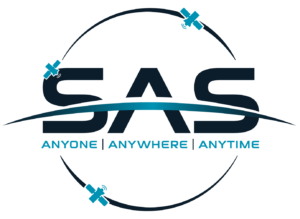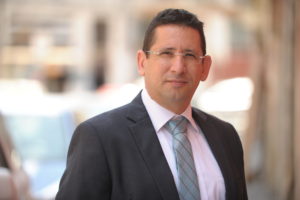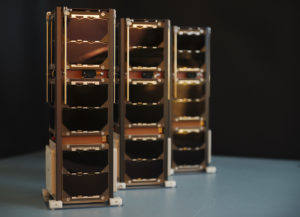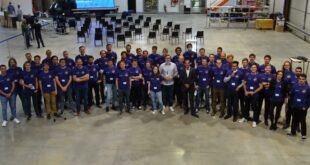 It is just over two months since SpaceWatch Middle East last spoke to Meir Moalem, CEO and Managing Director of Sky and Space Global (SAS). In that time, the company has come through a period of in-orbit testing of its 3 Diamonds satellites and, just last week, achieved a successful demonstration of their technology. Not only that, the team can claim a world first – the very first ever phone call over a nano-satellite. This is a game changer that holds the promise to literally change lives.
It is just over two months since SpaceWatch Middle East last spoke to Meir Moalem, CEO and Managing Director of Sky and Space Global (SAS). In that time, the company has come through a period of in-orbit testing of its 3 Diamonds satellites and, just last week, achieved a successful demonstration of their technology. Not only that, the team can claim a world first – the very first ever phone call over a nano-satellite. This is a game changer that holds the promise to literally change lives.
Helen Jameson, SpaceWatch Middle East’s Editor-in-Chief got the chance to catch up with Meir again, just after the company had made this groundbreaking announcement to get his reaction and to talk about the exciting future that is opening up for SAS.
Firstly, SpaceWatch Middle East would like to congratulate the entire SAS team on your successful technology demonstration and the first ever voice call over a nano-satellite. Can you please summarise what has happened since we last spoke in July?

We are very happy! We knew it would work but being a world first is a huge achievement. Last time we spoke was immediately after the launch and we were talking about the testing of the satellites etc. Well, that’s exactly what we did. We had really good communication with the satellites immediately after launch. Then we started to test all of the sub-systems and everything was fine. At the end of August, we completed the in-orbit testing which meant that we were confident that everything was working as it should: attitude control, the power systems, the computers. We then turned our attention to starting to test the payload itself. First, we tested the inter-satellite communication and that was really good. Then we tested the space to ground segment, initially making sure that the payload was transmitting and that we were getting a signal on the ground.
Then we progressed to the testing of the commercial payload. We tried to send a text message, and that was successful. The link to the satellite was fairly good so we continued to test the other capabilities such as sending datafiles, images, voice recordings and eventually we came to the point of testing a phone call. Everything worked as it should. We repeated the test just to be confident that it wasn’t a coincidence and that we did indeed know what we were doing. When we were happy with that, we announced it to the market and it is hard to overstate the importance of that. Of course, I am not objective, but proving that you can make phones calls with a nano-satellite the size of 30cm, 500km in space is a big achievement, not just for us, but for the whole space industry.
So far, we are the only NewSpace company that is looking at communications services. There are nano-satellites that will do Earth imagery commercially, but no one has tried to do that for the communications sector so I believe that more will follow now we have proved that it works and at the end of the day, everyone will benefit from that.
This is literally disruptive. What impact do you believe this will have?
I think that most of the impact will be on humanity. We are talking right now about how we assimilate 5G technology into cellular phones, when there are still people without even a first generation phone. I believe it will first transform humanity and impact a lot of lives, and open up possibilities. It’s the difference between giving someone a fish and a fishing rod. Instead of giving something to someone, you are providing them with the infrastructure that enables them to grow or to explore new avenues to develop themselves. I think it is very difficult to take in the level of impact that this will have.
For us, living in the western world, the effect will be limited. When we travel to Africa or South America, we can still read our emails and we are not disconnected. However, for the people living there, it brings with it improvement of their lives. I think it will enable economic growth, for example. For example, companies that were reluctant to go to certain areas to provide certain applications because there has previously been no good infrastructure may now rethink their strategy as this will open up new markets for them. If that happens, it will if course develop the economy.
You already have an MoU with SocialEco. Will this milestone catalyse the development of the $30 phone for the developing world?
SocialEco already offers a $1 phone in certain areas of the world. We do have an agreement with them that their customers will be offered the opportunity to use SAS services once they are fully deployed within 2 years from now.
The $30 smartphone is an idea that we are exploring together with SocialEco. Today, in order to use SAS technology, you need to have a smartphone and some kind of satellite terminal or modem to act as an interface to our system. The idea is to see whether we can integrate, into a smartphone, a satellite antenna and modem. Perhaps this would take a slightly larger smartphone or perhaps there would be a folding antenna in the back of the smartphone. Then, through mass production and the use of Social Eco’s unique business model, we envisage getting to the point where we can offer the phone for a target price of $30. This would be a complete game changer. Just think about the market it will open for the telephone companies such as Samsung, Apple, LG, etc. Immediately, you have hundreds of millions of potential customers who can purchase a phone which and acts not only as a satellite phone, but also a cellular phone. This is a very big challenge but has enormous potential. Of course, our track record of success helps us with this project.
Can you tell us more about the SAS services’ indoor capability?
This is very interesting. We have separated the satellite terminal part of the system from the interface part of the system. So just imagine, you have a small satellite terminal on your roof and you will connect that in some way to your hotspot router inside your house and then you can sit inside your building and connect with the satellite. This is a very important achievement for us because it opens up new system architectures and new possibilities for customers than before.
You have met this goal, yet there are many planned constellations out there with larger satellites than yours still figuring things out. However, here you are, launched, validated and way ahead of the game. That must feel good.
It is and it isn’t. It’s good that we are meeting our goals but at the end of the day, we started with a clear vision and we have been working very hard towards achieving this. We are doing this because we think it is the right thing to do. Having said that, there is no precedent to what we have been able to do in such a short period of time. We were listed less than 18 months ago. Already we have three satellites in space. We have achieved proof of technology and we are now on the way to building our constellation of 200 satellites. This is something that is quite remarkable, but it is also quite frightening. Working towards these kinds of goals at this rate, people ask us why we need to deploy the constellation by 2020? Wait for a few years. Take your time. But no. we have a clear vision, and we will work very hard to achieve that.

You have customers already on the 3 Diamonds. Are they using the satellite data services as yet?
They are not using the services at the moment, but they will be very, very soon. Now that the testing is over, the next phase is commercial demonstration. That’s where we are right now. We already have binding agreements with these customers so we know what they want and they now know that we can provide them with what they want. It’s just a matter of time now before we start providing the services. Please keep in mind that the 3 Diamonds were never meant to be commercial assets. They were developed to be technology demonstrators to prove that we could do it and then we could go to secure the $150 million to deploy the constellation. They became commercial assets due to the demand from the market and, as we have shown, we can offer the IoT and low data rate services which can be provided with a limited number of satellites.
You already have the customers lined up for the rest of the constellation. Will you be adding to them?
Yes that is correct. We will continue to add customers in other areas of the world and for other applications. We have customers from the telecommunications business, finance, agriculture, education, transportation – so we are trying to be very diverse and to open up new revenue streams.
Are you planning any further satellites beyond the 200 that are planned?
I could say no comment!
We have been talking about the possibility of expanding the equatorial constellation to a global constellation which would require around 1000 satellites. I would say that the exceptional team and the space experts that we have at SAS are very creative people, and we are always exploring new ideas and new possibilities to increase the value of the company to its shareholders.
Since the company was established, to meeting this major milestone, things appear to have gone smoothly for SAS. Is that the case and what is the secret behind your success?
First of all, it may look like this has been a smooth ride but it is not the case! It has been a bumpy ride and there are always challenges and difficulties and things that you need to tackle. But you push through and make sure that you fix it. It’s a lot of hard work. I think that it is mostly down to the exceptional team that we have in the company and a lot of preparation work. Although we have been listed for less than 18 months, the people in the company have years and years of experience and knowhow and the three founders (myself, Meidad Pariente and Yonatan Shrama), were working very hard before we got listed in order to prepare the ground so that once we got the funding and pushed the button, everything ran forward which is why we were quickly able to sign a contract for the satellites and the launches, to set up the subsidiaries, develop the software etc. The main challenge is keeping it up and making sure that all of the company is aligned on the same goals, working as a team, working hard, being open to new ideas, accepting criticism, being agile when you need to change. It’s not different from any other business.
SpaceWatch Middle East thanks Meir Moalem of Sky and Space Global for the interview.
Original published at: https://spacewatch.global/2017/09/spacewatchme-interviews-meir-moalem-sky-space-global/
 SpaceWatch.Global An independent perspective on space
SpaceWatch.Global An independent perspective on space

